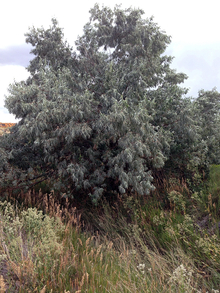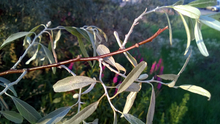Quick facts
Russian olive is an invasive species.
- Russian olive grows on streambanks, lakeshores and prairies.
- It is shade tolerant and can live in a variety of soil moisture conditions.
- It interferes with nutrient cycling and taxes water reserves.
Russian olive should be reported. The Minnesota Department of Natural Resources provides detailed recommendations for reporting invasive species.
How to identify Russian olive
- Large deciduous shrub or small tree, up to 25 feet tall.
- Spreading branches form into a dense rounded crown.
Stem
- Thin bark comes off in narrow, elongated, fibrous strips.
Branches
- Twigs are very flexible and have a terminal spine.
Leaves
- Alternate, distinctive silver-gray and lance shaped.
Flowers
- Yellow spicy-fragrant flowers found as individuals or in small clusters in the leaf axils.
- Blooms in late spring.
Fruit and seeds
- Dry, olive-like, and hard; seeds remain viable in the soil for 3 years.
Roots
- Capable of fixing nitrogen in the soil.
- Propagates by vegetative sprouts from buds formed on the root crown and by root suckers.
Reviewed in 2019



